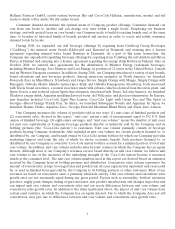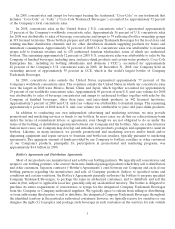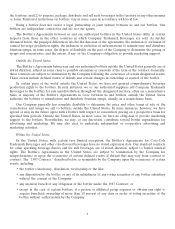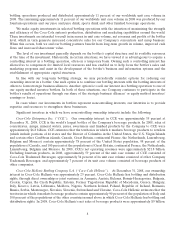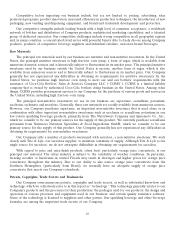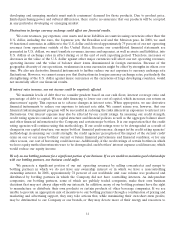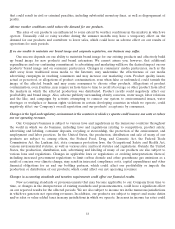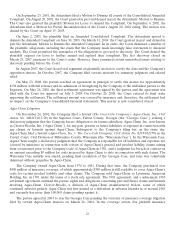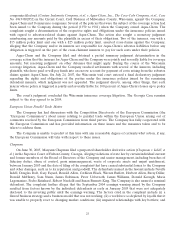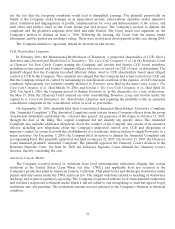Coca Cola 2008 Annual Report Download - page 16
Download and view the complete annual report
Please find page 16 of the 2008 Coca Cola annual report below. You can navigate through the pages in the report by either clicking on the pages listed below, or by using the keyword search tool below to find specific information within the annual report.developing and emerging markets must match consumers’ demand for those products. Due to product price,
limited purchasing power and cultural differences, there can be no assurance that our products will be accepted
in any particular developing or emerging market.
Fluctuations in foreign currency exchange could affect our financial results.
We earn revenues, pay expenses, own assets and incur liabilities in countries using currencies other than the
U.S. dollar, including the euro, the Japanese yen, the Brazilian real and the Mexican peso. In 2008, we used
69 functional currencies in addition to the U.S. dollar and derived approximately 75 percent of our net operating
revenues from operations outside of the United States. Because our consolidated financial statements are
presented in U.S. dollars, we must translate revenues, income and expenses, as well as assets and liabilities, into
U.S. dollars at exchange rates in effect during or at the end of each reporting period. Therefore, increases or
decreases in the value of the U.S. dollar against other major currencies will affect our net operating revenues,
operating income and the value of balance sheet items denominated in foreign currencies. Because of the
geographic diversity of our operations, weaknesses in some currencies might be offset by strengths in others over
time. We also use derivative financial instruments to further reduce our net exposure to currency exchange rate
fluctuations. However, we cannot assure you that fluctuations in foreign currency exchange rates, particularly the
strengthening of the U.S. dollar against major currencies or the currencies of large developing countries, would
not materially affect our financial results.
If interest rates increase, our net income could be negatively affected.
We maintain levels of debt that we consider prudent based on our cash flows, interest coverage ratio and
percentage of debt to capital. We use debt financing to lower our cost of capital, which increases our return on
shareowners’ equity. This exposes us to adverse changes in interest rates. When appropriate, we use derivative
financial instruments to reduce our exposure to interest rate risks. We cannot assure you, however, that our
financial risk management program will be successful in reducing the risks inherent in exposures to interest rate
fluctuations. Our interest expense may also be affected by our credit ratings. In assessing our credit strength,
credit rating agencies consider our capital structure and financial policies as well as the aggregate balance sheet
and other financial information for the Company and certain major bottlers. It is our expectation that the credit
rating agencies will continue using this methodology. If our credit ratings were to be downgraded as a result of
changes in our capital structure; our major bottlers’ financial performance; changes in the credit rating agencies’
methodology in assessing our credit strength; the credit agencies’ perception of the impact of the current credit
crisis on our or our major bottlers’ current or future financial performance and financial condition; or for any
other reason, our cost of borrowing could increase. Additionally, if the credit ratings of certain bottlers in which
we have equity method investments were to be downgraded, such bottlers’ interest expense could increase, which
would reduce our equity income.
We rely on our bottling partners for a significant portion of our business. If we are unable to maintain good relationships
with our bottling partners, our business could suffer.
We generate a significant portion of our net operating revenues by selling concentrates and syrups to
bottling partners in which we do not have any ownership interest or in which we have a noncontrolling
ownership interest. In 2008, approximately 78 percent of our worldwide unit case volume was produced and
distributed by bottling partners in which the Company did not have controlling interests. As independent
companies, our bottling partners, some of which are publicly traded companies, make their own business
decisions that may not always align with our interests. In addition, many of our bottling partners have the right
to manufacture or distribute their own products or certain products of other beverage companies. If we are
unable to provide an appropriate mix of incentives to our bottling partners through a combination of pricing and
marketing and advertising support, they may take actions that, while maximizing their own short-term profits,
may be detrimental to our Company or our brands, or they may devote more of their energy and resources to
14


